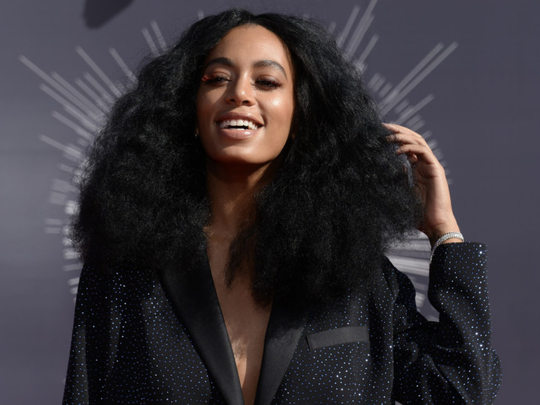
How do you get everyone to talk about your album? By barely talking about it. Or else by shouting the house down and throwing everything at the wall. There is, seemingly, no third way. Take the concurrent examples of Solange and Bon Iver. Both released their new (and third) albums on the same day. Bon Iver did the usual rounds of press interviews and radio promotion for months in advance, with reviews hailing 22, A Million as a modern masterpiece. Solange did no promo until A Seat at the Table was out, limiting it to a handful of interviews (W Magazine, The Fader, Stereogum) for maximum impact and only letting fans know it was coming three days in advance. Bon Iver got off to a strong start in the opening days but by the end of the week, Solange had edged it to No 1 in the US. We could hail this as proof that silence is the new loud as far as media obligations go, with the equation being “less press = more success”. Really, however, this is a triumph of counterintuitive marketing, where the old fail-safe of doing months of pre-release promo across all media has been replaced by giving little away and letting fawning fans on Facebook, Twitter, Instagram and musically do the grunt work.
Rather than being the disintermediation of promotion this is the social media takeover of promotion.
In amplified contrast, the marketing for Joanne, Lady Gaga’s fifth album (sixth if you count The Fame Monster), out on Friday, has left no promotional stone unturned. Every plate they could get their hands on is currently spinning furiously and it all started in January after she won a Golden Globe for her performance in American Horror Story. “You know, I am putting out an album this year,” she told reporters. “I won’t tell you when!”
The seed planted, things were quiet for several months, barring public appearances here and there. Then the machine defiantly roared into life at the end of September and hasn’t relented. Perfect Illusion, the album’s first single, was released on September 20, Million Reasons swiftly followed on October 6 and then A-YO came out on October 17; in little over a month, the album’s three lead singles had been punted out there with little breathing space between them.
Her confirmation of the Super Bowl half-time show next February came on September 29 and that marked the promo floodgates opening. The following is just some of the promotion she has done in the past three weeks: her brief Dive Bar tour, sponsored by Bud Light, opened in Nashville and she played four tracks from the new album; Twitter created a custom Lady Gaga emoji; clips from the album “mysteriously” leaked temporarily on Amazon via its Echo speakers; she was spotted filming a forthcoming appearance on Carpool Karaoke; Mattell made a Zomby Gaga doll for Monster High; she appeared on the cover of The Sunday Times’ Culture supplement; she was involved with the launch of Volume, SiriusXM’s new talk radio channel; she was interviewed by Zane Lowe on Beats 1; Mark Ronson joined her Dive Bar tour show in New York and it was streamed live on her website and Bud Light’s Facebook page; she appeared on the cover of the NME; a trailer for her upcoming appearance on this weekend’s Saturday Night Live with Tom Hanks went online the day before. Phew.
It feels like a concerted righting of the wrongs around the confused and confusing ARTPOP campaign in 2013 that included a hits-free performance at the iTunes Festival in London and a baffling “future of the album” app version that was nothing of the sort. This is proper belt and braces marketing, where every eventuality is covered off to ensure the album sails to No 1 in as many countries as possible next week. Despite the all-or-nothing marketing gamble for Joanne, it could prove the final gasp of the old idea of the album as the centre of gravity for campaigns. Solange has released just three albums in 13 years while Lady Gaga has put out four albums in the past five years. Different audiences, sure, but these are both clearly album campaigns. How long can the album stay the lingua franca of the charts? There are suggestions that Calvin Harris might scrap albums altogether in exchange for a steady chain of singles that keeps his profile high enough to ensure he remains the highest-paid DJ in EDM while others, from Gorgon City to The Raveonettes, are experimenting with putting out music on a rolling basis.
In this period of transition, the record industry is toggling between two dominant marketing approaches — the constantly rolling and always-on one of new singles every few months and one which is a bit more smash and grab with surprise releases. Record labels used to be after your money and now, with Spotify and Apple Music, they are after your time, streaming and re-streaming albums to keep them in the charts. Solange managed to turn the flashpoint release to her advantage for now, but others who deployed the same tactic have not fared quite so well in the long term. Rihanna’s Anti is at 15 after 38 weeks on the Billboard album chart in the US while Beyonce’s Lemonade is at 30 after 25 weeks. Frank Ocean’s Blonde, meanwhile, has slipped to 33 after just eight weeks and Radiohead’s A Moon Shaped Pool is nowhere to be seen in the top 200 after just 17 weeks.
Roaring out of the gates with an exciting and unexpected new release might propel you to the top of the charts in week one; staying there weeks and months later is the real trick. Also pre-loading all your promo into a window of three weeks before the album comes out might result in maximum impact but, really, there is nowhere to go after that, the momentum impossible to sustain. We could see Solange and Gaga as two different sides in a 2016 retelling of Aesop’s fable of the tortoise and the hare. You can either zip onto the racetrack at the last minute and zoom past your slow-but-steady competitors. Or you can take a year-long run up to it and rattle and clatter through it like a one-man band, setting off fireworks as you go, hoping it will detract and unnerve your chart rivals. Except the real test today is not how well you do on the first lap, but rather if you are still going by the 20th.












